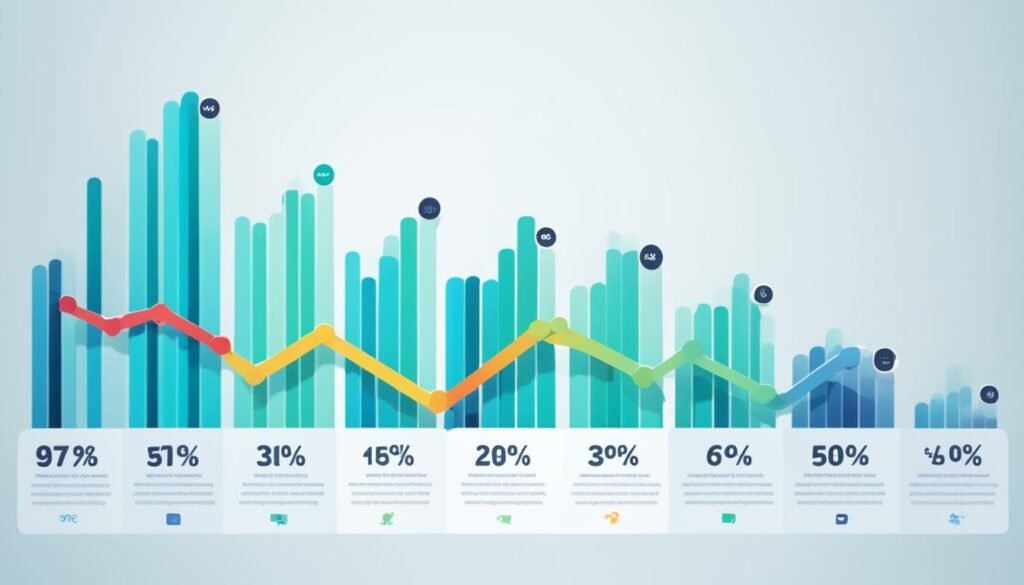To elevate your online presence and foster brand loyalty, it is crucial to have engaging social media content strategies. By creating valuable and compelling posts, you can captivate audiences and stand out on social media platforms. Building a long-term plan that aligns with your industry, audience, and goals is essential. This article will guide you on how to identify and set goals, research your audience, analyze your competitors, audit your current social content, choose the right content types, build a content calendar, promote and distribute your content, measure results, and craft your social media content plan.
Key Takeaways:
- Engaging social media content strategies are essential for elevating your online presence and fostering brand loyalty.
- Create valuable and compelling posts to captivate audiences and stand out on social media platforms.
- Building a long-term plan that aligns with your industry, audience, and goals is crucial for success.
- Identify and set specific goals that support your overall marketing objectives and tailor your content to meet them.
- Research your audience, develop buyer personas, and use social listening tools to understand their preferences and needs.
Identify and Set Goals
The first step in creating an effective social media content strategy is to identify and set your goals. By establishing clear goals, you provide a framework for your marketing efforts and ensure that your social media content aligns with your overall marketing objectives. Whether your aims lie in increasing brand awareness, driving website traffic, or boosting sales, defining your content goals allows you to tailor your strategy accordingly and measure your success.
When setting your goals, it’s important to be specific, measurable, achievable, relevant, and time-bound (SMART). This helps you create actionable targets that are realistic and relevant to your business. For example, a SMART goal could be to increase website traffic by 20% through social media content within the next three months.
Developing a social media content strategy without clear goals is like sailing without a destination – you won’t know if you’re heading in the right direction or if your efforts are paying off. By setting content goals that align with your marketing goals, you can create engaging and purposeful content that resonates with your audience while supporting your business objectives.
Why Are Goals Important?
Setting goals for your social media content strategy serves several purposes:
- Guidance: Goals provide a clear direction and focus for your social media content. They act as a roadmap, helping you determine what types of content to create, which platforms to use, and how to engage with your audience.
- Measurability: Goals allow you to track and measure the performance of your social media content. By establishing key performance indicators (KPIs) related to your goals, you can monitor your progress, make data-driven decisions, and identify areas for improvement.
- Motivation: Goals provide a sense of purpose and motivation for creating high-quality content. When you have a clear vision of what you want to achieve, it becomes easier to stay focused, overcome challenges, and continually innovate.
Ultimately, setting goals enables you to create a strategic and cohesive social media content strategy that supports your overall marketing efforts. By aligning your content goals with your marketing goals, you can ensure that every piece of content you create serves a purpose and contributes to your desired outcomes.
Example of Setting Content Goals
“Our company aims to increase brand awareness and engagement through our social media channels. We will set content goals to achieve the following:
- Increase overall brand reach by 25% within the next six months.
- Double the number of social media followers by the end of the year.
- Create compelling and shareable content that generates a monthly average of 500 user-generated content uploads.
- Consistently maintain an average engagement rate of 5% on all social media platforms.”
By setting these goals, we will be able to track our progress, adapt our strategy as needed, and ensure that our social media content is delivering results.”
Now that you understand the importance of setting goals for your social media content strategy, let’s move on to the next step: researching your audience.
Research Your Audience

To create content that resonates with your audience, it is important to research and understand their preferences and needs. By gaining valuable insights into their demographics, interests, and behaviors, you can tailor your content strategy to effectively engage and connect with them. Here are some key steps to guide you in researching your audience:
1. Develop Buyer Personas
Start by developing buyer personas, which are fictional representations of your ideal customers. These personas should encompass key characteristics such as age, gender, occupation, interests, and pain points. By creating detailed buyer personas, you can better understand your target audience and cater your content to their specific needs and preferences.
2. Gather Demographic Information
Use data and analytics tools to gather demographic information about your audience. This includes factors such as age, location, education, income level, and more. Understanding the demographics of your audience will help you create content that is relevant and relatable to them.
3. Analyze Conversations and Social Listening
Utilize social listening tools to monitor and analyze conversations related to your brand, industry, and products. This will provide insights into the pain points, preferences, and opinions of your audience. By understanding what they are saying, you can create content that addresses their concerns and aligns with their interests.
4. Collaborate with the Customer Care Team
Your customer care team is a valuable source of information when it comes to understanding your audience. Collaborate with them to gain insights into common FAQs, customer preferences, and pain points. Their firsthand interactions with customers can provide valuable feedback that can shape your content strategy.
By conducting thorough audience research, you can develop a deep understanding of your target market and create content that resonates with them. This will ultimately lead to higher engagement, increased brand loyalty, and a stronger connection with your audience.
Analyze Your Competitors

Conducting a competitive analysis is a crucial step in assessing the effectiveness of your social media content strategy. By studying and analyzing your competitors’ content, you can gain valuable insights, ignite inspiration, and establish benchmarks for your own strategy.
Through competitive analysis, you can assess the performance, strengths, and areas for improvement in your competitors’ content. By leveraging automation tools and social media data, you can gather metrics such as average engagements, growth rate, and top-performing content. This data-driven approach will enable you to set clear goals and refine your own content strategy to drive engagement, reach, and ultimately, business results.
“By analyzing our competitors’ content, we can identify gaps, find opportunities, and fine-tune our own strategy to differentiate ourselves in the market,” says Jane, Social Media Manager at XYZ Company.
Benefits of Competitive Analysis
- Identifying content gaps in the market
- Gaining inspiration and sparking new ideas for your own content
- Setting realistic benchmarks and goals for your social media strategy
- Understanding the competitive landscape and staying ahead of trends
- Identifying opportunities for differentiation and unique value propositions
Competitive Analysis Framework
When conducting a competitive analysis, it is important to follow a structured framework to ensure comprehensive coverage and meaningful insights. Here are the key steps:
- Identify your key competitors: Make a list of competitors in your industry or niche that you want to analyze.
- Analyze their social media presence: Assess their social media platforms, content themes, posting frequency, and engagement levels.
- Benchmark engagement metrics: Compare their average likes, comments, shares, and followers with your own performance.
- Assess content types and formats: Study the variety of content types they use, such as images, videos, and infographics.
- Examine content themes and messaging: Identify the key topics and messaging that resonate with their audience.
- Review audience interactions: Analyze how their audience engages with their content and any recurring trends or patterns.
- Explore partnerships and collaborations: Look for influencer collaborations or successful partnerships they have formed.
Competitive Analysis Example:
| Competitor | Average Engagements | Growth Rate | Top-Performing Content |
|---|---|---|---|
| Brand X | 2,500 | 10% | Behind-the-scenes videos |
| Brand Y | 3,000 | 15% | Infographics |
| Brand Z | 4,000 | 12% | Customer success stories |
Audit Your Current Social Content

Conducting a content audit on your current social media content is an important step in optimizing your social media strategy. By evaluating the performance of your posts and analyzing quantitative data, you can gain valuable insights into the effectiveness of your content and make informed decisions on how to enhance your brand awareness and follower count.
When conducting a content audit, consider key metrics such as follower count, impressions, and reach. These quantitative data points will allow you to identify the posts that have generated the most engagement and contributed to increased brand awareness. Look for patterns and trends in your content performance to understand what is resonating with your audience and what can be improved.
Additionally, examine the qualitative aspects of your content, such as the tone, messaging, and storytelling. Ensure that your content aligns with your brand values and resonates with your target audience. This qualitative analysis will help you understand the overall impact of your content and whether it effectively reflects your brand’s identity and goals.
By conducting a thorough content audit, you can gather comprehensive insights into the strengths and weaknesses of your social media content strategy. This analysis will serve as a foundation for future content creation, enabling you to align your content with your goals and optimize your social media presence.
Key Takeaways:
- Analyze quantitative data such as follower count, impressions, and reach
- Identify patterns and trends in your content performance
- Evaluate the qualitative aspects of your content, including tone and messaging
- Use the results of your content audit to inform and enhance your future content creation
Choose Your Content Types

To keep your audience engaged and maximize the impact of your social media content, it’s crucial to diversify your content types. By incorporating a variety of content formats, you can cater to different preferences and capture the attention of your target audience. Here are some content types you should consider incorporating into your social media strategy:
- Visual Content: Images and videos have proven to be highly engaging on social media platforms. Use eye-catching images and creative videos to capture your audience’s attention and convey your brand message effectively.
- User-Generated Content: User-generated content adds authenticity and builds trust with your audience. Encourage your followers to share their experiences and testimonials related to your brand, products, or services. This not only increases engagement but also strengthens your brand’s credibility.
- Short-Form Videos: Short-form videos, such as TikTok or Instagram Reels, have gained immense popularity. Use these platforms to create entertaining and informative videos that are concise and easily consumable.
Experiment with different content types and formats to find what resonates best with your target audience. Consider conducting audience research and analyzing engagement metrics to identify which content types are performing well for your brand.
Remember, the key is to create content that captures attention, fosters engagement, and aligns with your brand identity and message.
Build a Content Calendar

A content calendar is an essential tool for effective social media content planning. It allows you to visualize and organize your ideas, ensuring a consistent and strategic approach. By creating a content calendar, you can easily plan your content ahead of time and schedule it using social media management tools. This enables you to maintain a consistent posting schedule and frees up time for other important tasks.
One important aspect of building a content calendar is determining the best times to post on each social media platform. By analyzing data and considering factors such as audience demographics, engagement patterns, and peak activity times, you can identify the optimal posting times for maximum reach and interaction. This strategic approach ensures that your content is seen by the right people at the right time.
Cross-team collaboration is another crucial element of building a content calendar. By involving different team members within your organization, you can gather diverse perspectives and expertise in creating content that resonates with your target audience. Collaborating with your marketing, design, and customer support teams can bring valuable insights and ideas to the table, leading to a well-rounded content plan.
Creating a content calendar, determining the best times to post, and fostering cross-team collaboration all contribute to a successful social media content strategy. With a well-organized and strategic approach, you can ensure that your content is consistently delivered to your audience at the optimal times, increasing engagement and building brand loyalty.
Benefits of Building a Content Calendar
| Benefits | Description |
|---|---|
| Consistency | A content calendar helps you maintain a consistent posting schedule, ensuring a steady stream of content for your audience. |
| Organization | By visually mapping out your content ideas, a content calendar allows for better organization and planning. |
| Efficiency | Planning and scheduling content in advance saves time and allows for better multitasking and prioritization of tasks. |
| Cross-Team Collaboration | A content calendar encourages collaboration and communication among team members, leading to more diverse and impactful content. |
| Strategic Approach | With a content calendar, you can align your content with your marketing goals and ensure a more targeted and effective social media strategy. |
Promote and Distribute Your Content

Creating great content is only the first step. To maximize brand awareness, actively promote and distribute your content. Utilize social media scheduling and publishing features to schedule your content at the optimal times.
Encourage others to share your content and engage with your audience by responding to comments, asking questions, and reposting user-generated content. By actively participating in conversations and interactions, you can foster a sense of community and encourage engagement.
Remember, social proof plays a crucial role in building trust and credibility. Showcase positive reviews and testimonials from satisfied customers to demonstrate the value and impact of your content.
Actively distribute your content across different platforms, increasing its reach and impact. Leverage social media tools such as content distribution platforms to widen your audience reach and amplify your content’s visibility.
Creating engaging content is essential, but it’s equally important to ensure that it reaches your target audience effectively. Use social media analytics to gain insights into your content’s performance, identify which platforms generate the most engagement, and tailor your distribution strategy accordingly.
Engaging Social Media Platforms
| Social Media Platform | Key Features |
|---|---|
|
|
|
|
|
|
|
Remember to tailor your content distribution strategy to each platform’s strengths and your target audience’s preferences.
Measure Results

Measuring the performance of your social media content is crucial for understanding its effectiveness and optimizing your strategies. By utilizing social media analytics tools, you can track key metrics that provide valuable insights into the performance of your posts.
Key Metrics to Track:
- Engagement: Monitor the number of likes, comments, shares, and clicks your posts receive. This metric helps gauge how well your content resonates with your audience.
- Reach: Measure the number of unique users who have seen your posts. This metric indicates the visibility and potential reach of your content.
- Follower Growth: Keep an eye on the growth rate of your followers. This metric helps track the effectiveness of your social media efforts in attracting and retaining an audience.
- Conversions: Track how many users take the desired actions, such as signing up for a newsletter, making a purchase, or filling out a form after engaging with your social media content. This metric demonstrates the impact of your content on driving conversions.
By regularly analyzing the performance of your social media posts, you can identify patterns and trends that contribute to your content’s success. Look for commonalities among your top-performing posts, such as content type, theme, or engagement tactics.
Insightful quote: “Social media analytics empowers businesses to make informed decisions and create data-driven goals that align with audience preferences.” – Social Media Expert
Use the insights gained from social media analytics to set data-driven goals for your future content strategies. Incorporate the elements that have resonated well with your audience into your content planning and creation process. Continuously refine and optimize your content strategy based on the preferences and insights obtained from analyzing your post performance.
To further enhance your understanding of audience preferences, consider conducting surveys and gathering feedback directly from your followers. This will provide additional insights into their interests, needs, and expectations.
Remember, social media analytics is a valuable tool for guiding your content strategy and ensuring that your efforts align with audience preferences. By leveraging data-driven insights, you can continually refine and optimize your social media content to foster engagement, drive conversions, and achieve your goals.
| Metric | Definition |
|---|---|
| Engagement | The number of likes, comments, shares, and clicks your posts receive, indicating audience interaction and interest. |
| Reach | The number of unique users who have seen your posts, providing insights into the visibility of your content. |
| Follower Growth | The rate at which your social media following increases over time, indicating the effectiveness of your content in attracting and retaining an audience. |
| Conversions | The number of users who take desired actions, such as making a purchase or filling out a form, after engaging with your social media content. This metric measures the impact of your content on driving conversions. |
Also Read : Navigating Hacking In Social Media Safely
Conclusion
The world of social media is ever-evolving, and creating effective social media content is key to staying relevant and engaging with your audience. By understanding your audience, setting specific goals, and adapting to trends, you can create content that resonates and goes viral.
One of the most powerful ways to engage your audience is by leveraging attention-grabbing imagery and text. Visual content and compelling storytelling can evoke emotions and drive shares, helping your content reach a wider audience.
Timing is also crucial when it comes to social media success. By posting at the right times and leveraging influencer partnerships, you can maximize engagement and reach. Remember to actively engage with your audience by responding to comments, asking questions, and reposting user-generated content. These interactions not only foster a sense of community but also increase the visibility of your content.
To stay relevant, it’s important to keep up with platform changes and experiment with different types of content. By measuring the results of your social media efforts and analyzing audience preferences, you can continuously refine and optimize your content strategy.
In this journey, social media managers can be valuable allies. They have the expertise and experience to help you navigate the ever-changing landscape, ensuring your social media content is effective and aligned with your goals.
FAQs
Q: What are the different types of social media content?
A: The different types of social media content include text posts, images, videos, infographics, podcasts, user-generated content, and interactive content.
Q: How can I create engaging social media content?
A: You can create engaging social media content by understanding your audience, using a variety of content types, telling a story, using high-quality visuals, and engaging with your audience.
Q: Why do I need a social media content calendar?
A: A social media content calendar can help you plan and organize your content strategy, maintain consistency, and ensure that you are posting relevant and timely content.
Q: What are some content ideas for a social media presence?
A: Some content ideas for a social media presence include behind-the-scenes content, educational content, user-generated content, promotional content, and entertaining content that’s relevant to your audience.
Q: How can I create promotional content for social media?
A: You can create promotional content for social media by highlighting your products or services, offering special promotions or discounts, and creating engaging and visually appealing posts.
Q: What are the best types of social media content for a marketing campaign?
A: The best types of social media content for a marketing campaign include videos, interactive content, user-generated content, and behind-the-scenes content that gives a human touch to your brand.
Q: How can I find free social media content to share?
A: You can find free social media content to share by curating user-generated content, using royalty-free images and videos, collaborating with influencers for content, and sharing relevant industry news and updates.
Q: Why is it important to use a social media content calendar?
A: It’s important to use a social media content calendar because it helps you stay organized, maintain a consistent posting schedule, and strategically plan your content to align with your marketing goals.
Q: How can I use user-generated content on social media?
A: You can use user-generated content on social media by encouraging your audience to share their experiences with your product or service, running contests or challenges, and showcasing customer testimonials and reviews.
Q: What kind of content can I create on social media without a budget?
A: You can create behind-the-scenes content, educational posts, industry tips and insights, and inspirational quotes or stories without a budget, using your creativity and expertise to engage your audience.
Source Links
- https://www.searchenginejournal.com/create-engaging-social-media-content-tips/378521/
- https://sproutsocial.com/insights/social-media-content-strategy/
- https://www.linkedin.com/pulse/how-create-engaging-social-media-content-gets-shared-gall-she-her-





